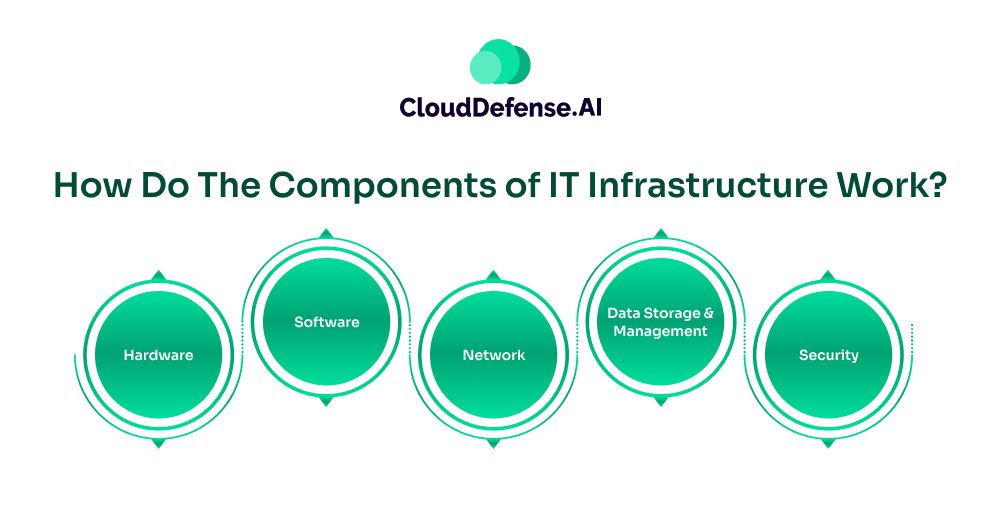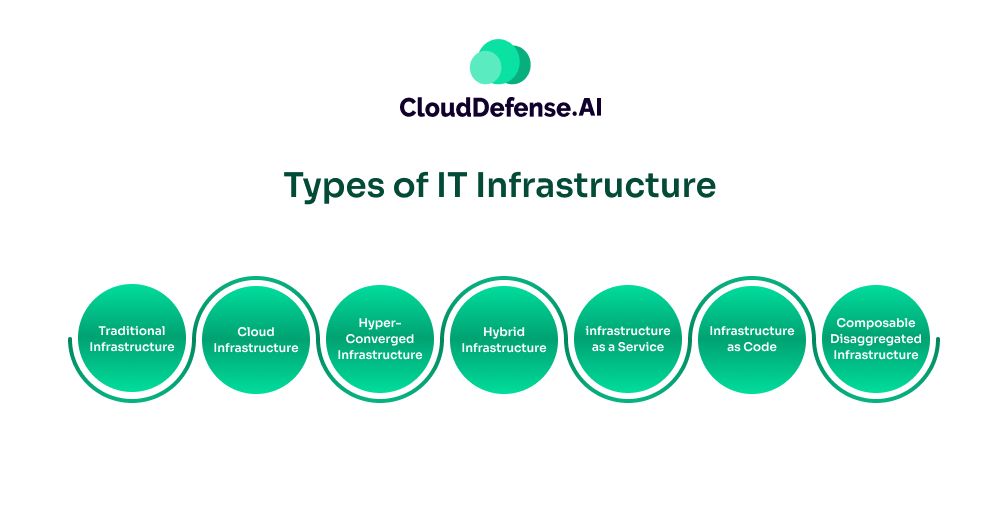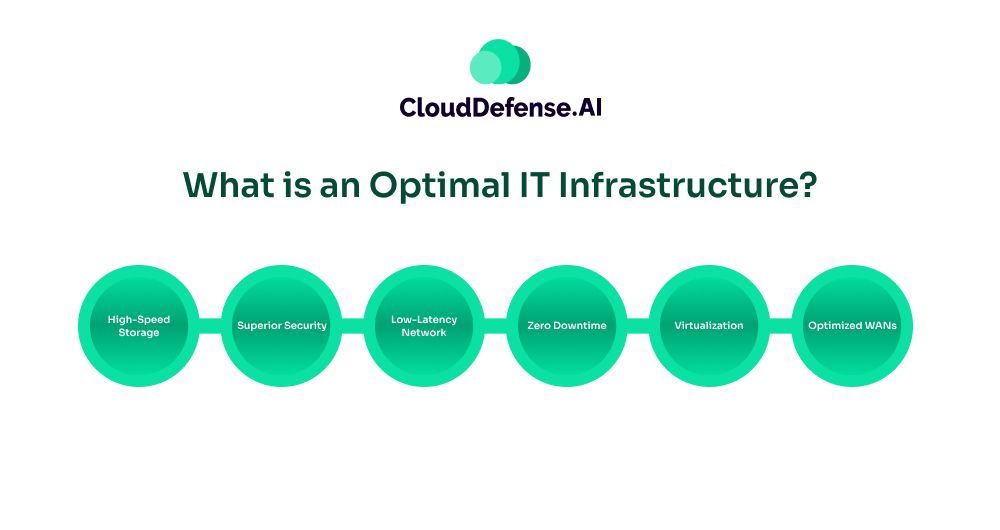What is IT Infrastructure?
Information technology or IT infrastructure refers to the set of IT assets like hardware, software, and networks utilized by organizations to maintain the operation and delivery of applications and IT services. Usually IT infrastructure is deployed within the organization’s own facility but in modern times they are deployed in a cloud environment.
It serves as the foundation as without it, a modern business can’t provide their application, scale their operation, or store information securely. From storage systems, servers, and operating systems to databases, IT infrastructures encompass almost all the necessary aspects of today’s business operation.
In today’s fast-paced digital transformation, IT infrastructure serves as a critical driver for a business to maintain its digital presence. When the IT infrastructure of a business is secure, reliable, flexible, and fast, it enables them to meet their business goal and create a strong digital presence.
Importantly, it also helps businesses to adapt to market changes, ease up daily operations, and facilitate seamless collaboration and communication. Basically, it serves as a determining factor whether a business will be profitable or not.
Why is IT Infrastructure Important?
As technology is advancing rapidly and organizations are getting more dependent on the digital environment, IT infrastructure provides the foundation for organizations to operate digitally. In the current scenario, technology is present in every aspect of the business and the organization needs to properly utilize it to increase operational efficiency, productivity, and growth.
Without a proper IT infrastructure modern businesses offering IT services and applications will cease to exist. Moreover, if the IT infrastructure of an organization isn’t reliable, secure, or poorly implemented, it will face productivity issues, security concerns, and disruptions in operation.
Organizations offering applications and services to customers greatly benefit from IT infrastructure because it enables them to provide uninterrupted access, leading to a positive customer experience.
By gathering and processing data in real-time and deploying solutions to market with speed, it is helping organizations to gain a lot of traction in the market and boost gains.
IT infrastructures offer a competitive edge and agility that every organization needs to stay ahead in today’s fast-paced industry. It helps them to adapt to technological advancement and rapidly deploy new services to get a competitive edge. It also enables businesses to scale their operation and utilize data insight to make data-driven decisions.
Another reason that makes IT infrastructure important is its support for cloud technologies. Through cloud computing, it enables organizations to offer modern applications and services without requiring any physical hardware or a huge deployment cycle.
Most importantly cloud technologies with the support of IT infrastructure can scale and meet the growing needs of the organization.
How Do The Components of IT Infrastructure Work?

IT infrastructures are made of some key components and each of them is interdependent on each. However, all the components are usually segregated into three core groups: hardware, software, and network.
Hardware utilizes software to operate whereas software uses or manages resources and hardware. Likewise, networking systems create connections between applications and physical resources. Let’s explore all the vital components of IT infrastructure:
Hardware
Hardware of IT infrastructures indicates the physical equipment that is utilized to build and maintain the IT environment. The hardware components include personal computers, hubs, switches, equipment, wires, facilities, and other hardware equipment that facilitates the working of the IT environment.
Endpoints like smartphones, laptops, and tablets are also counted as a vital component of modern IT infrastructure. The total number and types of hardware components vary from organization to organization.
Large enterprises usually have an extensive range of items which includes components of data center facilities and various peripherals like printers, and collaboration devices.
Software
Software components indicate the applications that are utilized by businesses to allow hardware to function. The hardware and software components work together for the IT infrastructure to work seamlessly.
The software component mainly covers operating systems, customer relationship managers, content management systems, enterprise resources planning, and web servers. The OS serves as the most vital part of this component because it manages all the hardware and system resources.
Besides this component also involved SaaS apps, licensed software, and in-house applications utilized by businesses. Application building and production environments like cloud and container also fall into this category.
Modern software components also involve software-based ANC, APIs, routers, and NGFW that help in building connections.
Network
Network component serves as a vital part of IT infrastructure as it allows all the devices to work together as a cohesive unit while utilizing both software and hardware components. The network component powers most parts of IT infrastructure which include SaaS apps and cloud-based processes.
From switches, routers, and servers to hubs and firewalls, network components include a lot of parts that enable network operation and communication between external and internal systems.
Routers enable the devices on varied LANs to communicate and exchange traffic between networks. Nowadays, software-based firewalls, SDN infrastructure, and application interfaces also fall into this category.
Additionally, a network in large enterprises also includes load balancers, WANs, and network protocols.
Data Storage and Management
In the modern data-driven industry, data storage and management also form a crucial part of modern IT infrastructure. Data storage is mostly about systems for storing, organizing, and managing all the data securely.
The primary task is to make the data accessible to users, secure from cyberattackers, and backed up during emergencies. Data storages are mostly maintained in data centers that ensure high availability, redundancy, and favorable operating conditions.
Security
Security also forms a critical part of modern IT infrastructure as it creates a defensive shield against all cyberattacks. This component involves security policies, firewalls, and protocols that safeguard all sensitive data and maintain the integrity of IT services.
System and device authentication and authorization, encryption, and intrusion detection and prevention are also involved in the security component.
Types of IT Infrastructure

Usually, when we think of IT infrastructure, we mostly consider traditional and cloud IT infrastructure. However, there are more types of IT infrastructure that are leveraged by organizations based on their requirements.
Here we will explore all the types of IT infrastructure an organization can adopt:
Traditional Infrastructure
Traditional infrastructure is the most common type of IT infrastructure that encompasses the usual hardware and software components utilized by enterprises. The components that a traditional infrastructure encompasses are data centers, servers, networking hardware, switches, computers, and enterprise software solutions.
The traditional infrastructure is maintained and owned by the enterprise itself. They are usually installed on the company-owned facilities and mostly dedicated for private usage. However, this type of IT infrastructure requires high operation costs and requires a lot of resources.
Cloud Infrastructure
A cloud IT infrastructure is the currently most popular type that is widely utilized by enterprises. This infrastructure mostly refers to the components and resources that are needed for cloud computing.
The overall infrastructure is similar to traditional IT infrastructure and the only change is that the resources are accessed over the Internet. Cloud IT infrastructure enables users to use computing resources through virtualization and that too without installing them on-premises facility.
Basically, it lets you utilize virtualization to use resources from a remote server-maintained cloud service provider. The cloud services are both available in private and public form. The cloud service provider basically lets you utilize all the resources over the internet at a nominal subscription fee.
Apart from the popular options, there are many other IT infrastructure that are often used by enterprises.
Hyper-Converged Infrastructure
Hyperconverged infrastructure is a unique type of IT infrastructure that enables an organization to manage network, data storage, computation, and other resources from a single interface.
In this type of IT infrastructure data storage and software computation are put together, enabling organizations to cater to modern workloads with expanding architecture.
Hybrid Infrastructure
Hybrid IT infrastructure is an emerging IT infrastructure type that combines cloud and on-premises infrastructure together to offer support.
The organization utilizes on-premises to run vital operations while cloud infrastructure takes care of various services offered to customers. Not only does it offer flexibility and balance in control but also eases up the operation cost.
Infrastructure as a Service
Infrastructure as a service or IaaS is a growing trend in today’s market and it enables users to use public cloud or virtual machines to run their applications and services.
Basically, it lets organizations use online services and move away from using and maintaining physical computing components. The whole infrastructure is maintained and provided by a third-party IaaS provider on a subscription model.
Infrastructure as Code
Another IT infrastructure type that organizations often prefer to rely on is infrastructure as code. Unlike others, this IT infrastructure gives flexibility to organizations to make changes and maintain architecture through software or lines of code.
IaC is an application that is applicable to both software and hardware IT components. When codes are strategically deployed, IaC enables the organization to efficiently provision resources, monitor different processes, and implement security policies.
Composable Disaggregated Infrastructure
Composable disaggregated infrastructure shares many similarities with converged infrastructure but it leverages IT components in its architecture. Gradually organizations are adopting this type of IT infrastructure as it enables data centers to operate as virtual servers and makes sure computational resources are allocated according to requirement.
Usually, this infrastructure type is built on a high-speed network to ensure resources are allocated quickly without any latency issues.
What is an Optimal IT Infrastructure?

Building an optimal IT infrastructure is a necessary requirement for every organization. However, it is not always the case as IT infrastructure varies from organization to organization based on their requirements and business strategies.
Optimal IT infrastructure is vital because it provides superior security, high-speed storage, virtualization, WAN, and low-latency network. Here detailed overview of each component that creates an optimal IT infrastructure:
High-Speed Storage
A vital requirement for an optimal IT infrastructure is high-speed storage that enables quick data storage and processing. It also involves a superior data recovery system that backs up data at a regular interval.
Superior Security
Superior security plays a crucial role in building an optimal IT infrastructure as it controls data availability and access to users and systems. It implements all the necessary security policies and solutions to breach cyberattacks and safeguard all the data.
Low-Latency Network
Low latency network is a necessity for IT infrastructure because it will ensure the high-speed data flow required when users use the application or services. It makes sure the customer has a seamless experience.
Zero Downtime
Zero downtime is necessary for an optimal IT infrastructure as it curbs operation disruption and eliminates the cost associated with downtime. It is highly useful in maintaining optimum customer experience.
Virtualization
In today’s cloud computing world, virtualization takes a crucial part in IT infrastructure. It helps the team provision faster servers, improve disaster recovery, maintain high uptime of servers, and prevent unnecessary usage of energy.
Optimized WANs
An optimized wide area network in IT infrastructure assists in managing the complete network. It not only prioritizes network traffic according to policies but also manages bandwidth according to the requirements of the application.
Final Words
Without a doubt, IT infrastructure serves as a backbone of all modern organizations especially those who are offering various applications and services. It lays the foundation for every organization to achieve high efficiency in operation, security, and security.
The primary purpose of IT infrastructure is to ensure business continuity, enhance service experience, streamline business processes, and reduce operation costs.
Every organization should work towards building an optimum IT infrastructure and employ best practices to get the best out of it. Through this article, we have put forward all the vital information you need to know when building your organization’s IT infrastructure and how it can benefit you.







